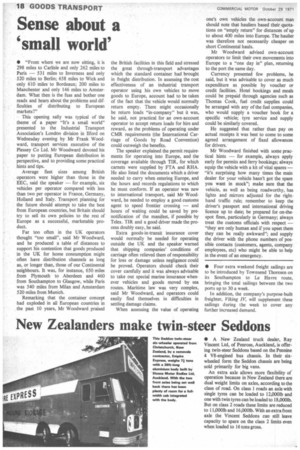Sense about a 'small world'
Page 20

If you've noticed an error in this article please click here to report it so we can fix it.
• "From where we are now sitting, it is 298 miles to Carlisle and only 262 miles to Paris — 531 miles to Inverness and only 520 miles to Berlin; 658 miles to Wick and only 610 miles to Bordeaux; 200 miles to Manchester and only 146 miles to Amsterdam. What then is the fuss and bother one reads and hears about the problems and difficulties of distributing to European markets?"
This opening sally was typical of the theme of a paper "It's a small world" presented to the Industrial Transport Association's London division in Ilford on Wednesday evening by Mr Frank Woodward, transport services executive of the Plessey Co Ltd. Mr Woodward devoted his paper to putting European distribution in perspective, and to providing some practical hints and tips.
Average fleet sizes among British operators were higher than those in the EEC, said the speaker — for example, six vehicles per operator compared with less than two per operator in France, Germany, Holland and Italy. Transport planning for the future should attempt to take the best from European countries, but Britain should try to sell its own policies to the rest of Europe as a successful, marketable product.
Far too often in the UK operators thought "too small", said Mr Woodward, and he produced a table of distances to support his contention that goods produced in the UK for home consumption might often have distribution channels as long as, or longer than, those of our Continental neighbours. It was, for instance, 650 miles from Plymouth to Aberdeen and 460 from Southampton to Glasgow, while Paris was 540 miles from Milan and Amsterdam 520 miles from Munich.
Remarking that the container concept had exploded in all European countries in the past 10 years, Mr Woodward praised the British facilities in this field and stressed the great through-transport advantages which the standard container had brought in freight distribution. In assessing the cost effectiveness of an industrial transport operator using his own vehicles to move goods to Europe, account had to be taken of the fact that the vehicle would normally return empty. There might occasionally be return loads "in-company" but it was, he said, not practical for an own-account operator to accept return loads for hire and reward, as the problems of operating under CMR requirements (the International Carriage of Goods by Road Convention) could outweigh the benefits.
The speaker explained the permit requirements for operating into Europe, and the coverage available through TIR, for which carnets were supplied by FTA and RHA. He also listed the documents which a driver needed to carry when entering Europe, and the hours and records regulations to which he must conform. If an operator was new to international transport, said Mr Woodward, he needed to employ a good customs agent to speed frontier crossing — and hours of waiting could be saved by prenotification of the manifest, if possible by Telex. TIR and a good driver made the process doubly easy, he said.
Extra goods-in-transit insurance cover would normally be needed for operating outside the UK and the speaker warned that shipping companies' conditions of carriage often relieved them of responsibility for loss or damage unless negligence could be proved. Operators should check their cover carefully and it was always advisable to take out special marine insurance whenever vehicles and goods moved by sea routes. Maritime law was very complex, said Mr Woodward, and operators could easily find themselves in difficulties in settling damage claims.
When assessing the value of operating one's own vehicles the own-account man should note that hauliers based their quotations on "empty return" for distances of up to about 400 miles into Europe. The haulier was therefore not necessarily cheaper on short Continental hauls.
Mr Woodward advised own-account operators to limit their own movements into Europe to a "one day in" plan, returning to the port the same day.
Currency presented few problems, he said, but it was advisable to cover as much expenditure as possible by voucher or credit facilities. Hotel bookings and meals could be prepaid through agencies such as Thomas Cook, fuel credit supplies could be arranged with any of the fuel companies, who would supply a voucher book for a specific vehicle; tyre service and supply could be similarly covered.
He suggested that rather than pay on actual receipts it was best to come to some agreed arrangement of fixed allowances for drivers.
Mr Woodward finished with some practical hints — for example, always apply early for permits and ferry bookings; always equip the vehicle with a kit of vital spares — "it's surprising how many times the main dealer for your vehicle hasn't got the spare you want in stock"; make sure that the vehicle, as well as being roadworthy, has lights and mirrors adjusted for the righthand traffic rule; remember to keep the driver's passport and international driving licence up to date; be prepared for on-thespot fines, particularly in Germany; always treat the customs officials with respect — "they are only human and if you upset them they can be really awkward"; and supply the driver with the phone numbers of possible contacts (customers, agents, company employees, etc) who might be able to help in the event of an emergency.
• Four extra weekend freight sailings are to be introduced by Townsend Thoresen on its Southampton to Le Havre route, bringing the total sailings between the two ports up to 30 a week.
In addition, the company's purpose-built freighter, Viking IV, will supplement these sailings during the week to cover any further increased demand.












































































































































